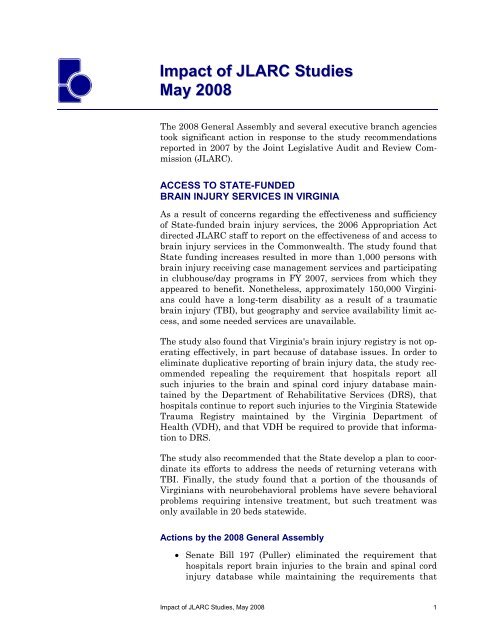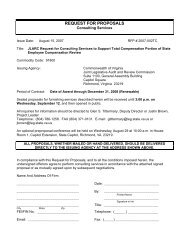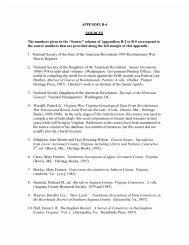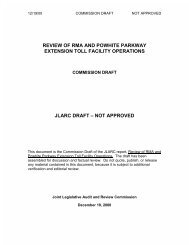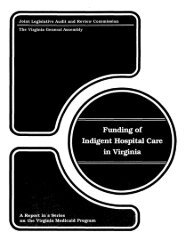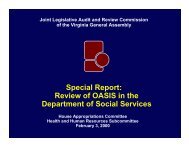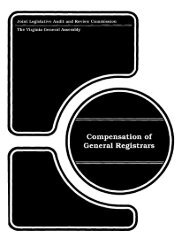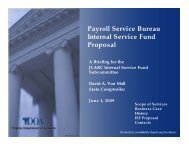2008 Legislative Impact of JLARC Studies - Virginia Joint Legislative ...
2008 Legislative Impact of JLARC Studies - Virginia Joint Legislative ...
2008 Legislative Impact of JLARC Studies - Virginia Joint Legislative ...
- No tags were found...
You also want an ePaper? Increase the reach of your titles
YUMPU automatically turns print PDFs into web optimized ePapers that Google loves.
<strong>Impact</strong> <strong>of</strong> <strong>JLARC</strong> <strong>Studies</strong>May <strong>2008</strong>The <strong>2008</strong> General Assembly and several executive branch agenciestook significant action in response to the study recommendationsreported in 2007 by the <strong>Joint</strong> <strong>Legislative</strong> Audit and Review Commission(<strong>JLARC</strong>).ACCESS TO STATE-FUNDEDBRAIN INJURY SERVICES IN VIRGINIAAs a result <strong>of</strong> concerns regarding the effectiveness and sufficiency<strong>of</strong> State-funded brain injury services, the 2006 Appropriation Actdirected <strong>JLARC</strong> staff to report on the effectiveness <strong>of</strong> and access tobrain injury services in the Commonwealth. The study found thatState funding increases resulted in more than 1,000 persons withbrain injury receiving case management services and participatingin clubhouse/day programs in FY 2007, services from which theyappeared to benefit. Nonetheless, approximately 150,000 <strong>Virginia</strong>nscould have a long-term disability as a result <strong>of</strong> a traumaticbrain injury (TBI), but geography and service availability limit access,and some needed services are unavailable.The study also found that <strong>Virginia</strong>'s brain injury registry is not operatingeffectively, in part because <strong>of</strong> database issues. In order toeliminate duplicative reporting <strong>of</strong> brain injury data, the study recommendedrepealing the requirement that hospitals report allsuch injuries to the brain and spinal cord injury database maintainedby the Department <strong>of</strong> Rehabilitative Services (DRS), thathospitals continue to report such injuries to the <strong>Virginia</strong> StatewideTrauma Registry maintained by the <strong>Virginia</strong> Department <strong>of</strong>Health (VDH), and that VDH be required to provide that informationto DRS.The study also recommended that the State develop a plan to coordinateits efforts to address the needs <strong>of</strong> returning veterans withTBI. Finally, the study found that a portion <strong>of</strong> the thousands <strong>of</strong><strong>Virginia</strong>ns with neurobehavioral problems have severe behavioralproblems requiring intensive treatment, but such treatment wasonly available in 20 beds statewide.Actions by the <strong>2008</strong> General Assembly• Senate Bill 197 (Puller) eliminated the requirement thathospitals report brain injuries to the brain and spinal cordinjury database while maintaining the requirements that<strong>Impact</strong> <strong>of</strong> <strong>JLARC</strong> <strong>Studies</strong>, May <strong>2008</strong> 1
hospitals report to the Statewide Trauma Registry and VDHshare the reported information with DRS.• House Bill 475 (Cox) addressed the need to monitor and coordinateaccess to State-level mental health services, includingservices for brain injury, by active and retired militarypersonnel. General Fund appropriations totaling $4.5 millionduring the two-year biennium were also approved forthis effort.EVALUATION OF CHILDREN’S RESIDENTIALSERVICES DELIVERED THROUGH THECOMPREHENSIVE SERVICES ACTIn 2006, <strong>JLARC</strong> staff were directed to evaluate the administration<strong>of</strong> the Comprehensive Services Act (CSA) because <strong>of</strong> concerns overrising program expenditures and the adequacy <strong>of</strong> regulations protectingchildren’s safety in residential facilities. The report concludedthat closer monitoring <strong>of</strong> residential placements and betteraccess to information about residential services could serve to controlprogram spending. In addition, the study found that addressinggaps in the availability <strong>of</strong> community-based services and fosterfamilies could yield substantial cost savings to the State while allowingmore children to be served in their homes and communities.Increasing compensation was recommended in the report as ameans to partially address the recruitment and retention issuesthat have constrained the availability <strong>of</strong> foster families. Recommendationswere also made to increase the State’s investment inlocal program administration as a means to address children’sneeds in the most cost-effective manner.The study also found that <strong>Virginia</strong>’s regulatory environment didnot appear to adequately protect the health and safety <strong>of</strong> childrenin residential facilities, and that residential services producedmixed outcomes. Although many residential providers reported exceedingminimum regulatory requirements, the report recommendedstronger standards be established to ensure that all facilitieswould provide a level <strong>of</strong> care sufficient to promote child safetyand positive outcomes.Actions by the <strong>2008</strong> General Assembly• House Bill 503 (Hamilton) required the State ExecutiveCouncil (SEC) to develop a program <strong>of</strong> case managementthat will better monitor residential care and ultimately controlassociated expenditures.<strong>Impact</strong> <strong>of</strong> <strong>JLARC</strong> <strong>Studies</strong>, May <strong>2008</strong> 2
• A companion to HB 503, Senate Bill 487 (Hanger) directedlocalities to utilize case management to monitor the progress<strong>of</strong> children placed in residential facilities.• Senate Bill 483 (Hanger) addressed performance measuresand data collection issues highlighted in the report. In particular,it requires the SEC to finalize performance standardsfor the CSA program and to collect information on thecost <strong>of</strong> services provided, regardless <strong>of</strong> funding source. SB483 also requires localities to provide additional informationabout the children who receive CSA-funded services.• Senate Bill 472 (Hanger) resolved that the Department <strong>of</strong>Education should no longer be the primary licensing agencyfor children’s residential facilities and should oversee onlytheir educational components.• Senate Bill 479 (Hanger) directed the Office <strong>of</strong> ComprehensiveServices to provide additional training for local staff regardingbest practices.Actions by the Executive Branch• New regulations pertaining to children’s residential facilitieswere adopted in December 2007. The new regulations addressseveral areas <strong>of</strong> concern raised in the study bystrengthening staff-to-child ratios; increasing educational,experience, and training requirements for facility staff; andrequiring providers to evaluate the quality <strong>of</strong> their programs.• Funding was allocated to increase the stipend paid to fosterfamilies.VIRGINIA PRESCHOOL INITIATIVE (VPI):CURRENT IMPLEMENTATION AND POTENTIAL CHANGESThe 2007 General Assembly directed <strong>JLARC</strong> to study the <strong>Virginia</strong>Preschool Initiative (VPI) and the concept <strong>of</strong> universal preschool.The VPI program was designed to make preschool available forfour-year-old “at-risk” children who are not otherwise served byHead Start. The program has been gradually expanded since itsinception in the mid-1990s, but there has not been a statewide assessment<strong>of</strong> the program. “Universal preschool” involves makinggovernmentally-supported preschool programs available to allchildren, whether at risk or not (actual participation is voluntarydepending on the wishes <strong>of</strong> the parents or guardians).The study concluded that VPI is a quality program which increasesthe preparedness <strong>of</strong> at-risk children for elementary school. VPImet most quality standards. Also, based on classroom observations<strong>Impact</strong> <strong>of</strong> <strong>JLARC</strong> <strong>Studies</strong>, May <strong>2008</strong> 3
y <strong>JLARC</strong> staff, classrooms appeared to provide a positive academicand social experience for students. VPI students do well inpre-kindergarten and kindergarten literacy tests, and kindergartenteachers and elementary school principals see at-risk prekindergartengraduates performing well. Data limitations meantthat conclusions could not be drawn about the long-term success <strong>of</strong>VPI graduates. The study also noted that the estimated per-pupilcost for quality preschool in urban and suburban school divisions isgreater than the $5,700 used by the State in determining Stateand local cost shares. Statewide, the typical per-pupil amount reportedby school divisions for providing high-quality preschool was$6,790.With regard to universal preschool, <strong>JLARC</strong> staff found that thereis a lesser body <strong>of</strong> compelling evidence relating to the benefits <strong>of</strong>preschool for children who are not at risk than for children who areat risk. Overall, available studies suggest that preschool can benefitchildren who are not at risk, but to a lesser extent than thebenefit for at-risk children. The study concluded that <strong>Virginia</strong>'scurrent focus for VPI—placing a priority on the children who havethe greatest needs and can benefit the most—appears to be appropriate.Actions by the Governor and <strong>2008</strong> General Assembly• The Governor’s budget bill proposed that applicants for VPIfunding could certify a per-pupil amount between $5,700 andthe $6,790 amount that was shown as an option in the<strong>JLARC</strong> report. Under this proposal, the State would provideits share <strong>of</strong> the cost <strong>of</strong> the certified amount.• The State budget as approved increased the per-pupilamount for VPI from $5,700 to $6,000. To further increaseparticipation, the approved budget also capped the requiredlocal share <strong>of</strong> the $6,000 cost at 50 percent.• Funding was provided in the approved budget to pay a Stateshare <strong>of</strong> 3,646 additional slots in FY 2009 (compared to FY<strong>2008</strong> participation levels), and to pay a State share <strong>of</strong> 1,029additional slots in FY 2010 (compared to FY 2009).INTERIM REVIEW OF THE RESULTS OF ABUSIVE DRIVERFEES IN VIRGINIA AND OTHER STATESIn October 2007, the Chairman <strong>of</strong> the <strong>Joint</strong> Commission on TransportationAccountability requested that <strong>JLARC</strong> staff conduct aninterim review <strong>of</strong> civil remedial fees, also known as abusive driverfees. These fees, which were assessed on persons convicted <strong>of</strong> certaindriving and motor vehicle-related <strong>of</strong>fenses, had been in place<strong>Impact</strong> <strong>of</strong> <strong>JLARC</strong> <strong>Studies</strong>, May <strong>2008</strong> 4
since July 1, 2007. The Chairman desired that <strong>JLARC</strong> staff assessany possible effects that the fees may have had on driving behaviorand State revenues, and to also include information on the effects<strong>of</strong> similar fees in other states.The study reached four main conclusions. First, a great deal <strong>of</strong> uncertaintyexisted among law enforcement <strong>of</strong>ficers and judges regardingwhich <strong>of</strong>fenses were subject to the fees. Second, data onarrest rates showed that the fees did not have a discernible deterrenteffect upon driving behavior. Third, revenue projections werebased on some uncertain assumptions and the original estimate <strong>of</strong>$65 million in annual revenues could be <strong>of</strong>f by as much as $28 millionin either direction. Fourth, because the penalty for nonpaymentwas suspension <strong>of</strong> driving privileges, more than 300,000suspension orders could be issued to <strong>Virginia</strong> drivers in the firsttwo years after the fees were imposed.Actions by the <strong>2008</strong> General Assembly• Senate Bill 1 (Houck) and House Bill 1243 (Hugo) repealedthe abusive driver fees.EVALUATIONS OF PROPOSED MANDATEDHEALTH INSURANCE BENEFITSThe Code <strong>of</strong> <strong>Virginia</strong> requires <strong>JLARC</strong> to provide staff assistance tothe Special Advisory Commission on Mandated Health InsuranceBenefits. <strong>JLARC</strong> staff are to evaluate the social and economic costsand benefits <strong>of</strong> proposed health insurance mandates. In 2007,<strong>JLARC</strong> staff evaluated three proposed mandates requiring coverage<strong>of</strong> the human papillomavirus (HPV) vaccine, second opinionsfor primary malignant brain tumor patients at NCI ComprehensiveCancer Centers, and prosthetic devices. <strong>JLARC</strong> staff alsoevaluated two proposals to repeal the mandated <strong>of</strong>fer for high-dosechemotherapy (HDC) with an autologous bone marrow transplant(ABMT) or stem cell transplant (SCT) for breast cancer.The <strong>JLARC</strong> staff evaluations found evidence to support the mandateproposals in two areas. The prosthetics mandate is consistentwith the role <strong>of</strong> health insurance and would establish a minimumlevel <strong>of</strong> coverage for individuals requiring prostheses. The repeal <strong>of</strong>the HDC-ABMT/SCT mandate is appropriate because recent researchhas determined that HDC-ABMT/SCT provides no additionalbenefit over conventional chemotherapy and is rarely usedin the treatment <strong>of</strong> breast cancer.The <strong>JLARC</strong> staff evaluations concluded that neither the proposedHPV mandate nor the second opinions mandate is necessary.<strong>Impact</strong> <strong>of</strong> <strong>JLARC</strong> <strong>Studies</strong>, May <strong>2008</strong> 5
There is already widespread coverage <strong>of</strong> the HPV vaccine, thoughit may be prudent to monitor insurance coverage levels for the vaccine.Medical experts indicated that it is not necessary to gain accessto a Comprehensive Cancer Center to obtain a high-qualitysecond opinion for primary malignant brain tumor patients. It appearsthat strengthening the clinical trials mandate may be a moreeffective approach to address the concerns <strong>of</strong> these patients.Actions by the Special Advisory Commission onMandated Health Insurance Benefits• The Special Advisory Commission voted to recommend theadoption <strong>of</strong> the prosthetics mandate and the repeal <strong>of</strong> theHDC-ABMT/SCT mandate. The Advisory Commission votednot to recommend the adoption <strong>of</strong> either the HPV or the secondopinions mandate.Actions by the <strong>2008</strong> General Assembly• Senate Bill 785 (Blevins) repealed the HDC-ABMT/SCTmandate.• House Bill 252 (O'Bannon) mandating coverage <strong>of</strong> secondopinions for primary malignant brain tumor patients at NCIComprehensive Cancer Centers was stricken from thedocket.• No bill mandating coverage <strong>of</strong> the HPV vaccine was proposedduring the <strong>2008</strong> Session.• Senate Bill 645 (Ticer) mandating coverage <strong>of</strong> prosthetic deviceswas continued to the 2009 Session. SB 645 incorporatesSenate Bill 13 (Edwards).<strong>Joint</strong> <strong>Legislative</strong> Audit and Review CommissionSuite 1100, General Assembly BuildingCapitol SquareRichmond, <strong>Virginia</strong> 23219http://jlarc.state.va.us<strong>Impact</strong> <strong>of</strong> <strong>JLARC</strong> <strong>Studies</strong>, May <strong>2008</strong> 6


